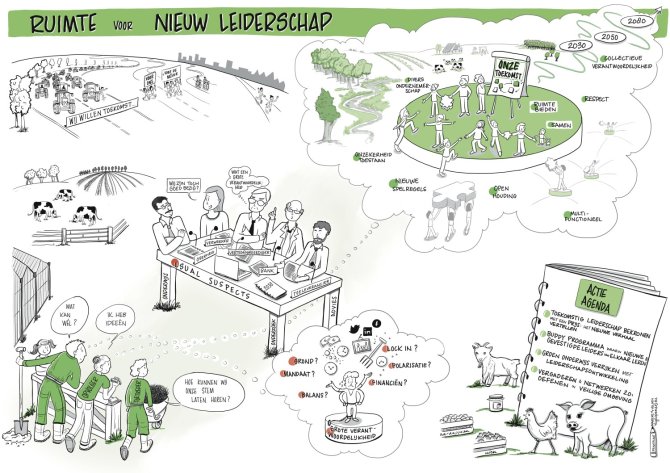The agricultural sector is under pressure due to significant challenges such as nitrogen emissions, climate change, and shifting societal demands. New leaders and more diverse forms of leadership offer opportunities to develop creative and effective solutions. But how do these new leaders experience their roles in practice? What obstacles do they encounter, and what opportunities do they see? These questions were central to interviews with innovative leaders and agrarian leadership experts.
New leadership does not only mean taking on official and formal leadership roles but also showing initiative in informal roles. This might involve educating others, writing opinion pieces, or speaking in the media. In today's agricultural sector, new leaders-such as young people, women, and individuals without an agricultural background-are often insufficiently heard. They are underrepresented in the places where important decisions are made. Nevertheless, despite their diverse backgrounds in sectors like horticulture, pig farming, and arable farming, these innovative leaders share a common vision for the future of leadership. This insight emerged during the development of an action agenda to promote new leadership in the sector, fuelled by government and sector organisations.
How these new leaders envision the future of leadership is illustrated in the visual summary below:

'Openness, collaboration, and diversity' form the core of the ideal image described by the interviewees. In this future vision, there is room for various forms of farming and leadership, with mutual respect and an open attitude towards new ideas and people. Diversity in governance structures and working methods is crucial here, as is providing opportunities for young people and innovative thinkers.
"These new leaders want to build a future-proof agricultural sector and a resilient business model. To achieve this, they say they need a long-term vision from politicians and industry organisations," explain researchers Aniek Hilkens and Else Giesbers from Wageningen Social & Economic Research (WSER).
Obstacles and opportunities
Although they share the same vision, the new leaders face similar obstacles. "The interviewees are all farmers and horticulturalists who are busy running their businesses. Many of their leadership activities are carried out alongside their daily work and personal responsibilities. Finding a balance here is challenging," says Aniek Hilkens. This issue is exacerbated by the lack of (financial) compensation for these activities.
Additionally, not all new leaders feel comfortable at formal meetings and events, where the established agricultural leadership gathers. While they acknowledge that decision-making does not exclusively happen through formal channels, they see these spaces as essential for exerting influence. Too often, influential positions are still held by the 'usual suspects'-familiar faces within the sector.
Established parties can help bring about change by actively creating space for new leaders. "One of the interviewees shared how she was offered a board position after others recognised her potential and enthusiasm. It was the established leaders who supported her," says Else Giesbers. The importance of mentors and role models is also highlighted: a supportive network proves to be crucial.
Action agenda: creating space for new leadership
To promote new leadership, the interview results were discussed at a meeting with representatives from government, financial institutions, agricultural organisations, agri-food processors, and new leaders. This led to four concrete action points:
- Tell a new story: Share inspiring examples of innovative leadership and make the need for change in the current system visible. This could include introducing an award for innovative leadership to raise its profile.
- Set up a buddy programme: Pair new and established leaders so they can learn from each other. "It's important that this learning goes both ways," emphasises Aniek Hilkens. "Established leaders can learn a lot from the fresh perspectives and innovative approaches of newcomers."
- Integrate leadership development into education: Leadership skills receive too little attention in agricultural education. By introducing these skills early, young people will be more inclined to take on leadership roles in the future. Professionals can also continue to develop their leadership skills.
- Develop new forms of meetings and networking: Create a safe, inclusive environment where new leaders feel welcome and where their ideas are taken seriously.
This project, carried out in collaboration with new leaders, provides valuable insights into the obstacles they face and the opportunities they see. It is crucial to disseminate these insights more broadly so that new leadership can contribute to a future-proof agricultural sector.
This seed money project was carried out on behalf of the Topsector voor Kennis en Innovatie (TKI) Agri & Food. It aligns with the objectives of the Knowledge and Innovation Agenda (KIA) Agriculture, Food, and Water to better harness the sector's innovative capacity. The research was conducted by Wageningen Social & Economic Research.






